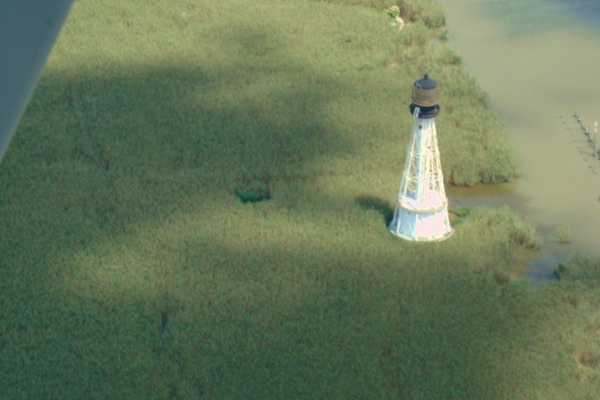Next was the faux light at the South Shore Harbor Resort in League City, Texas:
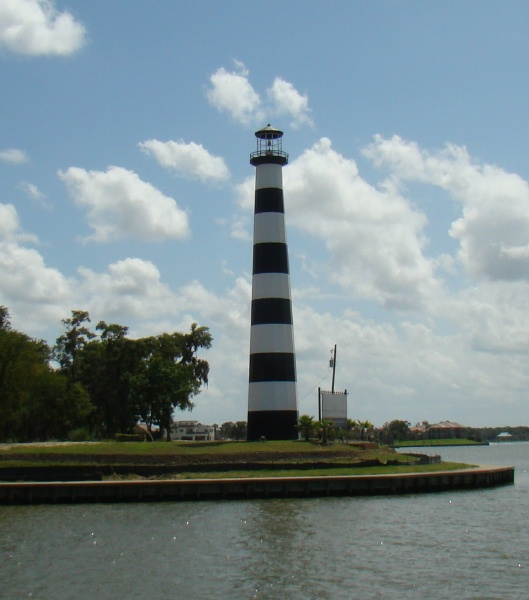
followed by the Sabine Bank Lighthouse Lantern Room and a section of the tower located in Lions Park, Sabine Pass, Texas.
About 16 miles south of the entrance to the Sabine River in the Gulf of Mexico the 30 mile long, 5 mile wide Sabine Bank is hidden only 20' below the surface of the water. Metalwork for a lighthouse that would rest on a caisson foundation sunk into the shoal was supplied by a Detroit, Michigan company and shipped by rail to Port Arthur. The lower courses of the caisson were assembled onshore and towed to the offshore site in June of 1904. A wooden cofferdam was built in the bottom of the caisson and connected to a central airshaft. This watertight chamber was then pressurized to keep the seawater out and allow men inside to remove the sand and muck below the bottom edge of the caisson. On July 21, 1904 the caisson had sunk to the target depth of 20' into the shoal. It was then filled with concrete, allowing a cylindrical area at its top to hold the station’s water cisterns.
Built at a cost of $101,354, the tower first exhibited the light from its 3rd-Order Fresnel lens on March 15, 1906. The 1915 hurricane tore away 75% of the gallery-level veranda, hatches, storm shutters, and two of the station’s boats. Seawater penetrated the tower and contaminated the station’s drinking water. The light was relit on August 23rd. Repairs after that storm included enclosing the gallery level with ¾” iron plates dotted with 13 air ports.
Unmanned after 1922, the site fell into a state of disrepair. When the condition of the lighthouse threatened the safety of those sent to maintain its light, a decision was made to replace the tower with a steel, skeleton structure. The Coast Guard solicited bids for the reconfiguration of the Sabine Bank Lighthouse in March of 2001. The structure above the caisson foundation was to be demolished and removed. The structural main deck at the top of the caisson was to be replaced with a new 55' tall steel skeleton tower on the main deck. The caisson foundation was to be rehabilitated and all steel surfaces above the water line were to be blasted and painted and new access ladders and main deck handrails were to be installed. The estimated price range was between $500,000 and $1,000,000.
A Jacksonville, NC company was awarded the contract and began the work in late January of 2002. A section of the lighthouse tower and the lantern room were dismantled and returned to shore where they were refurbished and placed on display at Lions Park in Sabine Pass, Texas. The original 3rd-Order Fresnel lens can be seen at the Museum of the Gulf Coast in Port Arthur.
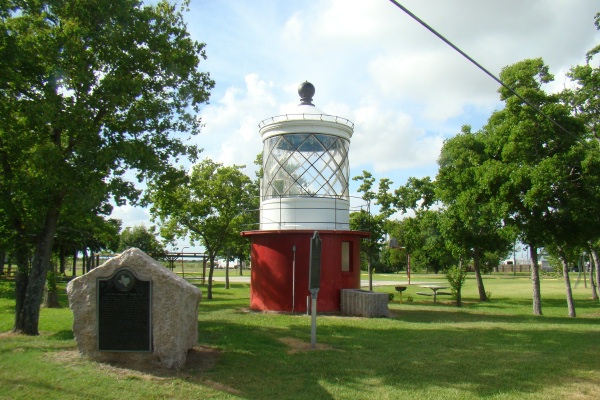
Stan had parked the car across the street from Lions Park on the grounds of the United Methodist Church. This faux lighthouse is located at that church. The sign beneath the bell indicates it is from the Sabine Pass Lighthouse and was purchased in 1897. I’ve written to the pastor of the church asking if she can provide additional information.
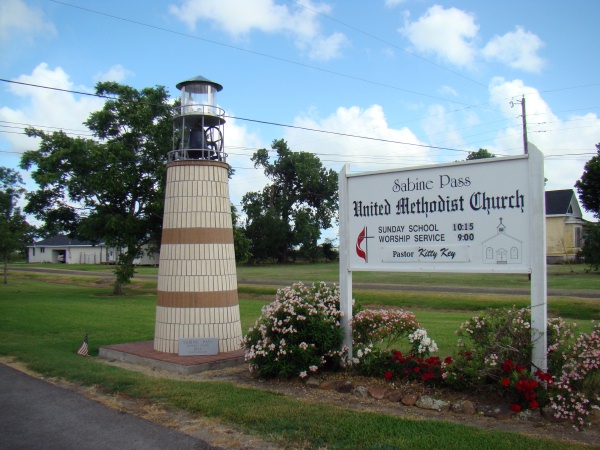
We were supposed to meet with Scotty Howell of Robinson Iron in Huntsville, AL to view the disassembled Mobile Point Lighthouse, but stormy weather prevented our taking a planned Saturday flight to view lighthouses in the Birdfoot Delta area. We opted instead to stay in Marrero, Texas another day (Stan got to watch Tiger’s matchup with Rocco Saturday and Sunday; I got to work on some of the pictures he’d taken since June 7th) and see if we could convince David Cusimo of Gulf Coast Aviation, Lakefront Airport, New Orleans, LA to take us out on Monday instead.
David was almost as excited about the lighthousing flight as I was–this was his maiden voyage for lighthouse viewing and, until he and I spoke in May, he wasn’t aware there was any interest in lighthouses! Gulf Coast Aviation is the only source I could locate offering any service that would allow for more than the pilot and a passenger. I’d given him the coordinates (thank you to Kraig Anderson and
www.lighthousefriends.com for his help), so we climbed aboard for the 2½-hour flight on Monday, 6/16/08.
First pass was over Pass a l’Outre Light. The tall iron tower in use at Head of Passes farther upstream was dismantled and relocated to a channel leading east originally named Pass a la Loutre, meaning “otter pass” referring to the abundance of these pelt-bearing animals. The mouth of the Mississippi is known as the Birdfoot Delta because the river branches out into three main channels, resembling the familiar 3-toed imprint left by shore birds. Otter Pass eventually became known as Pass a l’Outre, which means the “pass beyond.” The reassembled tower’s Fresnel lens was lit for the first time in its new location in December of 1855.
Put out of commission during the Civil War when Union force removed the Fresnel lens and Confederate soldiers burned the keeper’s dwelling, the light returned to service in April of 1863. A new keeper’s dwelling was built and the iron tower received a new brick liner and a thick coat of coal tar for rust prevention.
The keeper’s dwelling rested on nine brick piers. By 1868 it had settled 3' into the soft ground. The tower also started to sink around the same time. The floor of the lighthouse was originally 8' above the ground. By 1876 water from high tides was flooding the tower floor. The floor was raised 5' and the doorway heightened to provide continued access to the tower.
The depth of the channel was reduced to just 7' by the end of the 19th Century. Alternative routes had to be taken by large vessels. The tower was given a spiral black and white daymark in its final years of service. Although the station was decommissioned in 1930, the Coast Guard used it as a lookout for spotting rumrunners during prohibition.
The spiral bands started to fade by the 1950s and the tower is only covered by rust and graffiti today. No outbuildings remain at the station. With less than 50% of its original height showing above ground, the marshlands are slowly swallowing this stoic sentry.
The nine brick piers that once held the keeper’s dwelling and the lantern room, loosened by Hurricane Katrina in 2007, can be seen in this overhead shot.
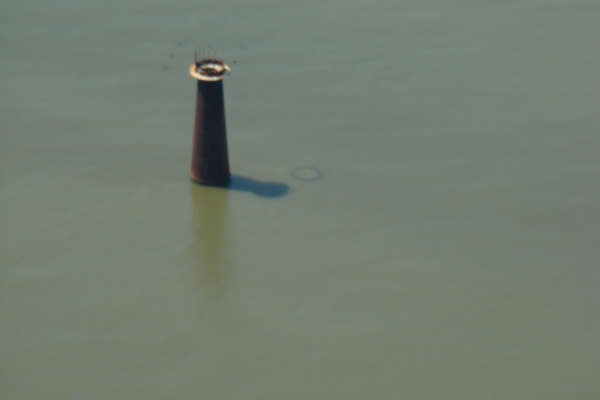
Next was South Pass Lighthouse. This tall iron tower is still active. Its 1st-Order Fresnel lens was replaced in 1951 with a modern beacon. Located at the entrance to South Pass, where water from the Mississippi River mixes with that of the gulf, this white skeletal tower is also known as Port Eads lighthouse. Port Eads was a bustling building camp in the 1870s when master builder James Eads put his experimental jetties in place. By constricting the outflow of South Pass, the jetties succeeded in scouring out the channel entrance to a depth of 30'. Large steamers could now access the river safely, saving millions of dollars annually in maritime insurance. During the 20 years following the completion of the jetties, trade at New Orleans doubled.
Though buried beneath layers of sand, the Eads Jetties still survive. In 1982 they were designated a National Historic Engineering Landmark and a commemorative plaque denoting this can be seen a few miles upriver at Fort Jackson.
This is the 4th South Pass Lighthouse. The first masonry tower was built by Winslow Lewis and its lamps were first lit in May of 1832. A storm in 1841 destroyed all signs of the station’s existence. Winslow Lewis also built a replacement–an octagonal wooden tower that used the original tower’s lighting apparatus. Completed in June of 1842, it was so decayed after just 5 years that another replacement was required. Another wooden octagonal tower (#3) rising to a height of 54' with a 40' x 30' Victorian dwelling built into its base was constructed at the pass.
The 3rd light was scheduled for deactivation following the completion of an iron tower at Southwest Pass, but when Eads’ jetties improved the channel at South Pass, the Lighthouse Board decided to place an iron tower at South Pass, too. Completed in 1881, the hexagonal tower is 105' tall and has a 2-story, iron-clad dwelling built into its base.
